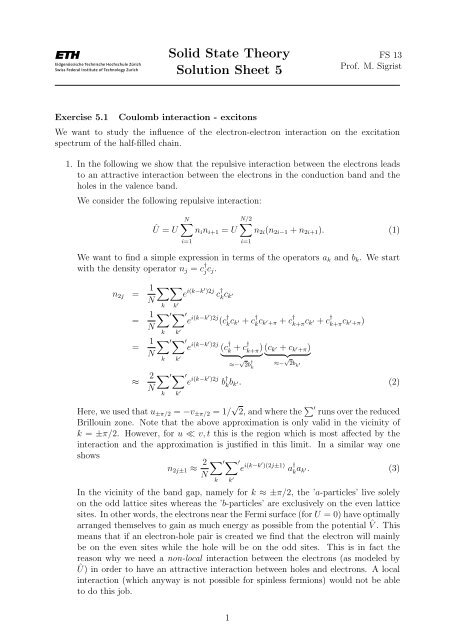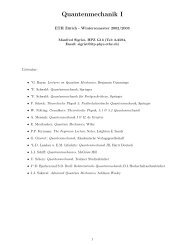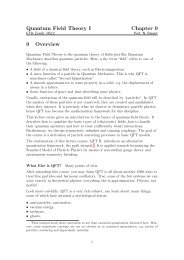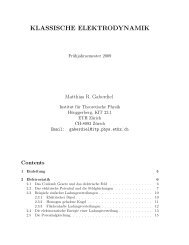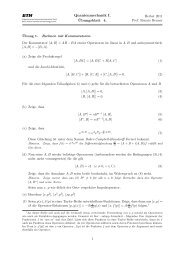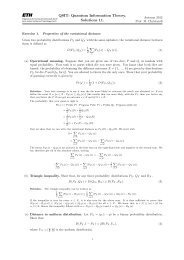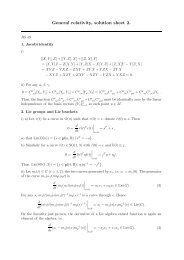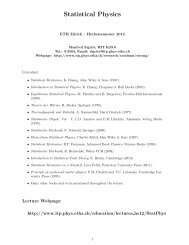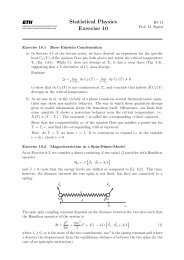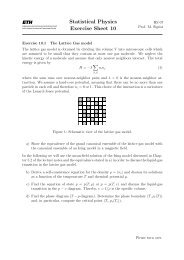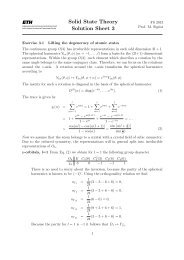Solid State Theory Solution Sheet 5
Solid State Theory Solution Sheet 5
Solid State Theory Solution Sheet 5
Create successful ePaper yourself
Turn your PDF publications into a flip-book with our unique Google optimized e-Paper software.
<strong>Solid</strong> <strong>State</strong> <strong>Theory</strong><br />
<strong>Solution</strong> <strong>Sheet</strong> 5<br />
FS 13<br />
Prof. M. Sigrist<br />
Exercise 5.1<br />
Coulomb interaction - excitons<br />
We want to study the influence of the electron-electron interaction on the excitation<br />
spectrum of the half-filled chain.<br />
1. In the following we show that the repulsive interaction between the electrons leads<br />
to an attractive interaction between the electrons in the conduction band and the<br />
holes in the valence band.<br />
We consider the following repulsive interaction:<br />
Û = U<br />
N/2<br />
N∑<br />
∑<br />
n i n i+1 = U n 2i (n 2i−1 + n 2i+1 ). (1)<br />
i=1<br />
i=1<br />
We want to find a simple expression in terms of the operators a k and b k . We start<br />
with the density operator n j = c † j c j.<br />
n 2j = 1 ∑∑<br />
e i(k−k′ )2j c † k<br />
N<br />
c k ′<br />
k k ′<br />
= 1 ∑′∑′ e<br />
i(k−k ′)2j (c † k<br />
N<br />
c k ′ + c† k c k ′ +π + c † k+π c k ′ + c† k+π c k ′ +π)<br />
k k ′<br />
= 1 ∑′∑′ e<br />
i(k−k ′)2j (c † k<br />
N<br />
+ c† k+π ) (c k ′ + c<br />
} {{ } } {{ k ′ +π)<br />
}<br />
k k ′ ≈− √ 2b † ≈− √ 2b<br />
k<br />
k ′<br />
≈<br />
2 ∑′∑′ e<br />
i(k−k ′)2j b † k<br />
N<br />
b k ′. (2)<br />
k k ′<br />
Here, we used that u ±π/2 = −v ±π/2 = 1/ √ 2, and where the ∑′ runs over the reduced<br />
Brillouin zone. Note that the above approximation is only valid in the vicinity of<br />
k = ±π/2. However, for u ≪ v, t this is the region which is most affected by the<br />
interaction and the approximation is justified in this limit. In a similar way one<br />
shows<br />
n 2j±1 ≈ 2 ∑′∑′ e<br />
i(k−k ′)(2j±1) a † k<br />
N<br />
a k ′. (3)<br />
k k ′<br />
In the vicinity of the band gap, namely for k ≈ ±π/2, the ’a-particles’ live solely<br />
on the odd lattice sites whereas the ’b-particles’ are exclusively on the even lattice<br />
sites. In other words, the electrons near the Fermi surface (for U = 0) have optimally<br />
arranged themselves to gain as much energy as possible from the potential ˆV . This<br />
means that if an electron-hole pair is created we find that the electron will mainly<br />
be on the even sites while the hole will be on the odd sites. This is in fact the<br />
reason why we need a non-local interaction between the electrons (as modeled by<br />
Û) in order to have an attractive interaction between holes and electrons. A local<br />
interaction (which anyway is not possible for spinless fermions) would not be able<br />
to do this job.<br />
1
Using Eqs. (2), (3) and (1) we obtain<br />
Û ≈ 4U<br />
≈<br />
∑<br />
′ N/2<br />
N 2<br />
k 1 ,...,k 4 j=0<br />
4U<br />
N<br />
∑<br />
With the substitution<br />
∑<br />
e i(k 1−k 2 +k 3 −k 4 )2j (e i(k 3−k 4 ) + e −i(k 3−k 4 ) )b † k 1<br />
b k2 a † k 3<br />
a k4 (4)<br />
k 1 ,...,k 4<br />
′<br />
δk1 +k 3 ,k 2 +k 4<br />
cos(k 3 − k 4 )b † k 1<br />
b k2 a † k 3<br />
a k4 . (5)<br />
k 1 → k k 2 → k ′ k 3 → k ′ + q k 4 → k + q (6)<br />
the constraint k 1 + k 3 = k 2 + k 4 is automatically fulfilled and we obtain<br />
Û ≈ − 4U N<br />
∑<br />
k,k ′ ,q<br />
′<br />
cos(k − k ′ )a k+q b † k b k ′a† k ′ +q<br />
+ 4U ∑ b †<br />
✟ ✟✟✟✟✟ k b k<br />
(7)<br />
k<br />
as on the exercise sheet. The minus sign in the above equation stems from the<br />
exchange of the fermionic operator a † k ′ +q<br />
with three fermionic operators. This minus<br />
sign is very important since it yields an attraction between electrons and holes. In<br />
addition, in Eq. (7) we dropped a term proportional to the total number of electrons<br />
in the conduction band which is irrelevant for the following discussion.<br />
2. The Hamilton operator H = H 1 + Û with the approximation (7) for Û separately<br />
preserves the number of electrons and holes and therefore we can use the following<br />
ansatz for the wave function of the exciton:<br />
|ψ q 〉 = ∑ k<br />
′<br />
A<br />
q<br />
k a k+qb † k<br />
|Ω〉. (8)<br />
Note that this ansatz yields exact eigenstates of H only in the case when Û is<br />
approximated according to Eq. (7). The exact Û does not preserve the number of<br />
electrons and holes separately and leads to a complicated many-body problem.<br />
The coefficients A q k and the excitation energy ω q of the exciton have to be determined<br />
such that<br />
( ˜H 1 + Û)|ψ q〉 = ω q |ψ q 〉 (9)<br />
where ˜H 1 = H 1 −E 0 , meaning that energies are measured with respect to the ground<br />
state energy E 0 . For this we need the action of Û on an exciton state,<br />
and the action of ˜H 1 ,<br />
Û|ψ q 〉 = − 4U N<br />
∑′∑<br />
k ′<br />
k ′′ ′<br />
A<br />
q<br />
k ′ cos(k ′ − k ′′ )a k ′′ +qb † k ′′ |Ω〉, (10)<br />
˜H 1 |ψ q 〉 = ∑ k<br />
′<br />
A<br />
q<br />
k (E k + E k+q )a k+q b † k<br />
|Ω〉. (11)<br />
Consequently, the Eq.(9) written component by component has to hold<br />
(E k + E k+q − ω q )A q k = 4U N<br />
2<br />
∑<br />
k ′<br />
′<br />
A<br />
q<br />
k ′ cos(k ′ − k) (12)
Figure 1: Graphical solution of Eq. (16), for q = 0, V/t = 1 and N = 8 (left) and<br />
N = 20 (right). We are looking for solutions with energy smaller than the band gap<br />
(indicated by dashed line in left plot), such that ω q=0 < 2V . The plots show that a<br />
solution exists for each such ω q=0 . The sum in Eq. 16 has a divergent term for each k<br />
(when ω q=0 = 2E k , corresponding to a particle-hole excitation energy), and so we expect<br />
as many divergencies as there are k values. This is illustrated by the two different plots<br />
for N = 8 and for N = 20, which due to their different lengths have a different number of<br />
allowed (discrete) k values. Notice also that if the energy of the exciton becomes larger<br />
than the difference between the valence band bottom and conduction band top, there are<br />
no more particle-hole excitations.<br />
We assume that U ≪ V, t. In this case the bound state will be strongly extended in<br />
real space, meaning that A q k<br />
is localized in k-space. Therefore, in Eq. (12) we can<br />
put the cos-factor out of the sum and approximate it by 1. 1 Then, dividing both<br />
sides by (E k + E k+q − ω q ) and summing over k yields<br />
1<br />
4U = 1 N<br />
∑<br />
k<br />
′ 1<br />
E k + E k+q − ω q<br />
. (16)<br />
The solutions of this equation for q = 0 for a small chain (N = 8) and a larger chain<br />
(N = 20) are shown in Fig. 1. Note that there is an exciton excitation with energy<br />
smaller than the gap ∆ = 2V . Now we have revealed a bound state called exciton.<br />
3. In the following we want to calculate the energy dispersion ω q of the excitons for<br />
1 The proper way how to solve the Eq. (12) is to use<br />
cos(k − k ′ ) = cos k cos k ′ − sin k sin k ′ , (13)<br />
and write down two self-consistent equations for F q 1 ≡ ∑ ′<br />
k ′ Aq k<br />
cos k ′ and F q ′ 2 ≡ ∑ ′<br />
k ′ Aq k<br />
sin k ′ by dividing<br />
′<br />
Eq. (12) by (E k + E k+q − ω q ), multiplying by cos k (or sin k) and subsequent summation over k:<br />
F q 1 = 4U ∑′ F q 1 cos2 k + F q 2 cos k sin k<br />
, (14)<br />
N E k + E k+q − ω q<br />
F q 2 = 4U N<br />
k<br />
∑<br />
k<br />
′ F q 1 cos k sin k + F q 2 sin2 k<br />
E k + E k+q − ω q<br />
, (15)<br />
and the non-trivial solution of this homogeneous set of equations exist only if the determinant vanishes...<br />
As you see the approximation greatly simplifies the further analysis.<br />
3
small q. For this we write the sum as an integral<br />
1<br />
4U = I := 1 1<br />
2 N/2<br />
′∑ 1<br />
= 1 1<br />
E k + E k+q − ω q 2 π<br />
k<br />
∫ π/2<br />
−π/2<br />
dk<br />
E k + E k+q − ω q<br />
. (17)<br />
For small u the integral has to become large. Since the exciton energy lies within<br />
the gap the main contributions to the integral are from the vicinity of k = ±π/2.<br />
We therefore expand the denominator around k = ±π/2 and for small q’s:<br />
E k + E k+q ≈ 2V + 2t2<br />
V<br />
((k ∓ π 2 )2 + (k + q ∓ π 2 )2 )<br />
} {{ }<br />
2(k ∓ π 2 + q 2 )2 + q2<br />
2<br />
So the denominator has minima 2V + t 2 q 2 /V at k = ±π/2 − q/2. For small U, ω q<br />
is only little less then the minimum and almost all the contributions come from the<br />
vicinity of the minimum. Therefore, we introduce a cutoff Λ and write the integral<br />
symmetrically around 0,<br />
(18)<br />
I ≈ 1 ∫ Λ<br />
2π −Λ<br />
dk<br />
2V + t2 q 2<br />
− ω<br />
V q + 4t2 k 2<br />
V<br />
= 1<br />
√ ∫ V<br />
˜Λ<br />
dx<br />
2π 4t 2 −˜Λ a 2 + x , (19)<br />
2<br />
where we have defined a 2 = 2V − ω q + t 2 q 2 /V . Finally, we obtain<br />
I ≈ 1<br />
√<br />
V 1<br />
( x<br />
)∣<br />
√<br />
∣∣˜Λ V<br />
2π 4t 2 a arctan 1<br />
≈<br />
a −˜Λ 4t 2 2a . (20)<br />
Here we let the cutoff to infinity. <strong>Solution</strong> ω q of Eq. (17) yields the dispersion<br />
ω q = 2V − U 2 V<br />
t 2<br />
+ t2<br />
V q2 = 2V − U 2 V<br />
t 2 + q2<br />
2(2m ∗ )<br />
(21)<br />
where m ∗ = V/(4t 2 ) is the effective mass near the energy gap. Thus, the electronhole<br />
pair has twice the mass of a single electron or hole.<br />
4. To show how f(r − r ′ ) is related to A 0 k , we insert the Fourier expansion of<br />
a k<br />
= 1 ∫ L<br />
dre ikr a (r) , b † k<br />
2L<br />
= 1 ∫ L<br />
dr ′ e −ikr′ b † (r ′ ) , (22)<br />
−L<br />
2L −L<br />
into the continuous form of the exciton state (for now considering finite volume,<br />
thus k = nπ/L),<br />
|ψ q=0 〉 = ∑ k<br />
A 0 ka k<br />
b † k |Ω〉 = 1 ∫ L<br />
dx dx ′ 1 ∑<br />
A 0<br />
2L −L 2L<br />
ke ik(r−r′ )<br />
k<br />
} {{ }<br />
f(r−r ′ )<br />
a (r)b † (r ′ ) . (23)<br />
Now we do a limit L → ∞ to conclude that<br />
f(ρ) = 1 ∫<br />
dkA 0<br />
2π<br />
ke ikρ . (24)<br />
R<br />
4
In order to evaluate f(ρ), we use eq. (12) (note that the right-hand-side is a constant),<br />
so that A 0 k ∝ (2E k − ω 0 ) −1 ; plugging into Eq. (24) yields to<br />
∫ ∞<br />
f(ρ) ∝ m ∗ e ikρ<br />
dk<br />
k 2 + m ∗ (2V − ω 0 ) ; 2V − ω 0 > 0 ; (25)<br />
−∞<br />
which can be evaluated using the method of residues. Note that f(ρ) is real due to<br />
antisymmetry of the imaginary part of the integral. Moreover, f(ρ) is symmetric, as<br />
f(−ρ) = f(ρ) ∗ = f(ρ). For ρ > 0, the contour may be closed in the upper half of the<br />
complex plane where there is a single simple pole located at ˜k = i √ m ∗ (2V − ω 0 ),<br />
so that λ = [m ∗ (2V − ω 0 )] −1/2 .<br />
Exercise 5.2<br />
Graphene<br />
f(ρ) ∝ m ∗ (2πi) ei˜k|ρ|<br />
2˜k ∝ e−|ρ|√ m ∗ (2V −ω 0 ) , (26)<br />
We want to calculate the π-energy bands of graphene using the tight-binding method.<br />
Those bonds are due to electrons in the 2p z orbitals. Graphene has two inequivalent<br />
carbon atoms per unit cell, which we call A and B.<br />
The primitive lattice vectors ⃗a i join atoms on the same sublattice (A or B), so that the<br />
reference points of the unit cells (the A-atoms in Fig. 2) form a triangular lattice. Setting<br />
the lattice constant a to unity they are given by<br />
(√ )<br />
3<br />
⃗a 1 =<br />
2 , 1 2<br />
(√ )<br />
3<br />
⃗a 2 =<br />
2 , −1 . (27)<br />
2<br />
The reciprocal lattice vectors ⃗c i can be found as usually by demanding that they satisfy<br />
⃗c i · ⃗a j = 2πδ ij . (28)<br />
This leads to<br />
(<br />
⃗c 1 = √ 4π<br />
√ )<br />
1 3<br />
3 2 , 2<br />
( )<br />
⃗c 2 = √ 4π 1<br />
3 2 , −√ 3<br />
2<br />
(29)<br />
With the reciprocal lattice vectors the Brillouin zone can be constructed and is seen to be<br />
a regular hexagon (Fig. 2). Note that after identifying points that differ by a reciprocal<br />
lattice vector only two of the corners are inequivalent.<br />
Next we find the general form of the tight-binding model for the bands originating in the<br />
p z -orbitals when only nearest neighbor hopping is taken into account. The p z -orbitals are<br />
symmetric under the rotations of the plane so that the hopping matrix elements do not<br />
depend on the direction. Hence we have only one hopping parameter, which we denote<br />
5
2<br />
3<br />
A<br />
b 1<br />
B<br />
y<br />
x<br />
a 1<br />
a 2<br />
Γ<br />
c<br />
K<br />
M<br />
k x<br />
k y<br />
c<br />
Figure 2: Left: Primitive lattice vectors for the honeycomb lattice. The vectors join points<br />
on one triangular sublattice. Right: Hexagonal Brillouin zone constructed from the reciprocal<br />
lattice vectors ⃗c 1 and ⃗c 2 .<br />
by t. Furthermore, every A-atom has neighbors in B only. The onsite terms have to be<br />
the same on both sublattices, so that they can be absorbed into the chemical potential<br />
(we work at fixed filling with two electrons per unit cell).<br />
To describe the hopping terms we define the vectors<br />
( )<br />
⃗ 1<br />
b1 = √3 , 0 ,<br />
(<br />
⃗ −1<br />
b2 =<br />
2 √ 3 , 1 )<br />
, and<br />
2<br />
(<br />
⃗ −1<br />
b3 =<br />
2 √ 3 , −1 )<br />
(30)<br />
2<br />
that point from an A atom to its three nearest neighbors. Denoting the postion of the<br />
i-th atom on sublattice A by ⃗ R a,i , the Hamiltonian is given by<br />
H = t ∑ i<br />
3∑<br />
j=1<br />
( ) ( [c † ⃗Ra,i c ⃗Ra,i + ⃗ ) ]<br />
b j + h.c. . (31)<br />
Now we use the Fourier transform given on the exercise sheet,<br />
( )<br />
c ⃗Ra,i<br />
1 ∑<br />
= √<br />
N<br />
to find<br />
H = t N<br />
= t ∑ k∈BZ<br />
( )<br />
c ⃗Rb,i<br />
∑<br />
k,k ′ ∈BZ<br />
(<br />
ã†<br />
k<br />
˜b†<br />
k<br />
ã † k˜b k ′<br />
=<br />
∑<br />
i<br />
) ( 0<br />
1 ∑<br />
√<br />
N<br />
⃗ k∈BZ<br />
ã k e i⃗ k· ⃗R a,i<br />
⃗ k∈BZ<br />
˜bk e i⃗ k· ⃗R b,i<br />
, (32)<br />
e i ⃗ R a,i (k ′ −k)<br />
3∑<br />
e i⃗ k ′·⃗b j<br />
+ h.c.<br />
j=1<br />
∑<br />
j ei⃗ k·⃗b j<br />
∑<br />
j e−i⃗ k·⃗b j<br />
0<br />
6<br />
) (<br />
ãk<br />
˜bk<br />
)<br />
. (33)
Figure 3: left: Dispersion of the two bands of graphene. At half-filling (one electron per p z -<br />
orbital), the Fermi ’surface’ consists of two points at the two inequivalent corners of the Brillouin<br />
zone. right: Dirac cone in the vicinity of the point ⃗ k = (2π/ √ 3, 2π/3)<br />
The dispersion is found by diagonalizing the 2 × 2-matrix Hamiltonian which yields<br />
(√ )<br />
ɛ k = ± t √ 3<br />
3 + 4 cos<br />
2 k x cos k y<br />
2 + 2 cos k y. (34)<br />
The two bands are shown in figure 3. With two electrons per unit cell the lower band is<br />
completely filled whereas the upper band is empty, so that µ = 0.<br />
Now we can find the position of the Fermi points displayed in figure 3 by solving<br />
3∑<br />
e i⃗ k·⃗b j<br />
= 0. (35)<br />
j=1<br />
Inserting the definition of ⃗ b j in (30) and writing equations for the real and imaginary<br />
parts separately we have<br />
( ) ( )<br />
qx<br />
qx<br />
(<br />
cos √ + 2 cos 3 2 √ qy<br />
)<br />
cos = 0 and (36)<br />
3 2<br />
( ) ( )<br />
kx<br />
qx<br />
sin √ − 2 sin 3 2 √ cos( k y<br />
) = 0, (37)<br />
3 2<br />
which has as solutions ⃗q 1 =<br />
( )<br />
√2π<br />
3<br />
, 2π and ⃗q<br />
3<br />
2 = ( )<br />
0, 4π 3 , i.e. the two inequivalent corners of<br />
the Brillouin zone. Note that both bands touch at these points. Next we obtain the low<br />
energy Hamiltonian by expanding (33) to linear order around the corners of the Brillouin<br />
zone, so that<br />
H eff ≈ − 3√ 3t<br />
8π<br />
∑<br />
k<br />
2∑<br />
i=1<br />
(<br />
Ψ † i (⃗ k) ˆσ x ⃗q i · ⃗k + ˆσ y (ˆɛ⃗q i ) · ⃗k<br />
)<br />
Ψ i ( ⃗ k), (38)<br />
where ˆɛ is the antisymmetric tensor and σ i are the Pauli matrices. The effect of the<br />
ansisymmetric tensor is as follows when summing over i: if i = 1 we have q 1 in the first<br />
term and −q 2 in the second (and vice versa). The Ψ i describe the electrons at the Fermi<br />
point q i , and have two components for each i describing the upper and the lower band.<br />
7
The momenta ⃗ k are relative to the Fermi points (i.e. shifted by ⃗q i ). The corresponding<br />
low energy dispersion is E = ±v F |k|, which resembles the relativistic energy-momentum<br />
relation E 2 = m 0 c 4 + p 2 c 2 for a massless particle and the speed of light replaced by the<br />
Fermi velocity. In fact, (38) is equivalent to the Dirac equation in (2 + 1)-dimensional<br />
spacetime. The Fermi sea below each Fermi point corresponds to the Dirac sea (vacuum<br />
for anti-particles), and the two Fermi points correspond to the two different chiralities of<br />
spin-1/2 particles in relativistic QFT. This fact allows studying some of the more puzzling<br />
aspects of the Dirac equation (such as the Klein paradox, see e.g. M. I. Katsnelson et al.,<br />
Chiral tunnelling and the Klein paradox in graphene, Nature Physics 2, 620 - 625 (2006)).<br />
8


